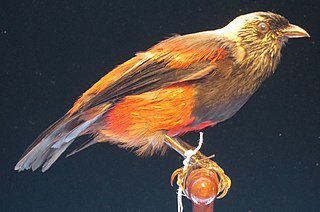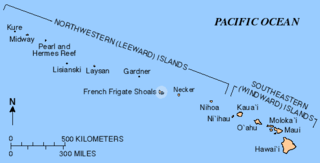Located about 2,300 miles (3,680 km) from the nearest continental shore, the Hawaiian Islands are the most isolated group of islands on the planet. The plant and animal life of the Hawaiian archipelago is the result of early, very infrequent colonizations of arriving species and the slow evolution of those species—in isolation from the rest of the world's flora and fauna—over a period of at least 5 million years. As a consequence, Hawai'i is home to a large number of endemic species. The radiation of species described by Charles Darwin in the Galapagos Islands which was critical to the formulation of his theory of evolution is far exceeded in the more isolated Hawaiian Islands.

The ʻula-ʻai-hāwane is an extinct species of small Hawaiian honeycreeper. The term ʻula-ʻai-hāwane is a Hawaiian phrase translating to "red [bird] that eats hāwane". It was only ever reported from the forested mountains of the Kohala, Hilo and Kona districts on the island of Hawaiʻi. Fossil remains reveal that it also existed at one time on other Hawaiian islands. The species is named after Anna Dole, wife of Sanford B. Dole.

Agrotis is a genus of moths of the family Noctuidae. The genus was erected by Ferdinand Ochsenheimer in 1816. A number of the species of this genus are extinct.
The poko noctuid moth is a moth in the family Noctuidae. The species was first described by Arthur Gardiner Butler in 1881.

The Midway noctuid moth, also known as Midway mudworm, is a species of moth in the family Noctuidae. It is now possibly extinct and was endemic to Midway Atoll.

Kerr's noctuid moth is a species of moth in the family Noctuidae.

The Laysan noctuid moth is a species of moth in the family Noctuidae.

Agrotis photophila, the light-loving noctuid moth, is a species of moth in the family Noctuidae. It is endemic to Oʻahu, Hawaiʻi, United States.

The Procellaris Agrotis noctuid moth is a species of moth in the family Noctuidae.
Genophantis leahi was a species of moth in the family Pyralidae described by Otto Herman Swezey in 1910. It was endemic to the Hawaiian islands of Maui, Oahu, Molokai and Hawaii.
The confused moth is an extinct species of moth in the family Noctuidae.

The Kona giant looper moth is an extinct species of moth in the family Geometridae. The species was first described by Edward Meyrick in 1899. It was endemic to Hawaii.
Agrotis cremata was a moth in the family Noctuidae. It is now presumed extinct.
Agrotis melanoneura was a moth in the family Noctuidae. It is now an extinct species.

Agrotis microreas was a moth in the family Noctuidae. It is now an extinct species.
Agrotis tephrias was a moth in the family Noctuidae. It is now an extinct species.
This page is based on this
Wikipedia article Text is available under the
CC BY-SA 4.0 license; additional terms may apply.
Images, videos and audio are available under their respective licenses.








